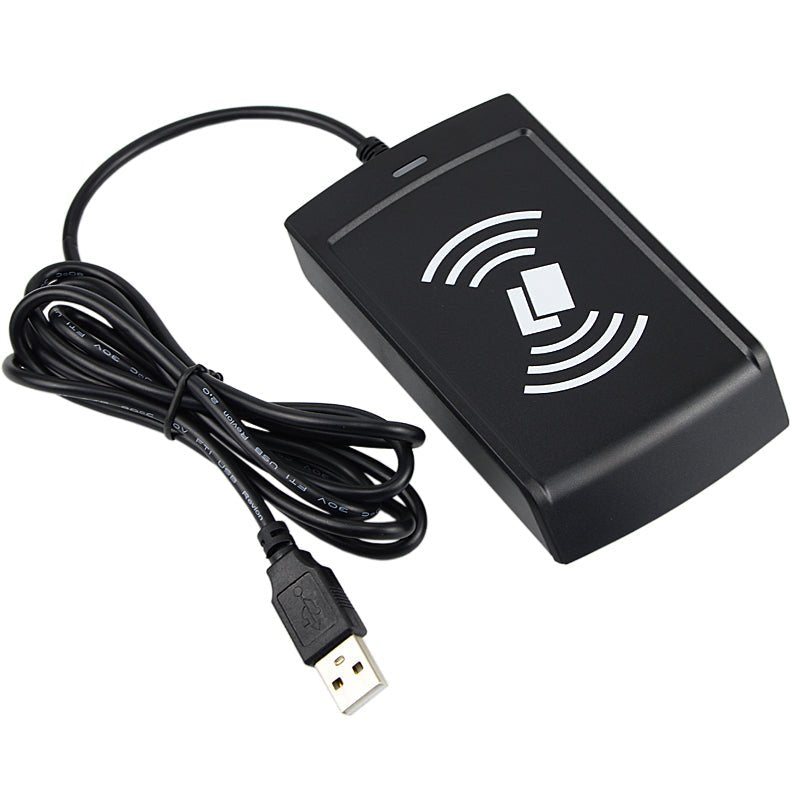
مجموعة من 10 قارئات بطاقات RFID USB منخفضة التكلفة بتردد 13.56 ميجاهرتز
وصف:
قارئ بطاقة USB RFID هو قارئ بروتوكول ISO14443A مصنوع من وحدة قارئ M8، يستخدم بشكل أساسي لتطوير البرمجيات وقراءة البطاقات المصرفية، وقد فاز بشهادة EMC، مع أداء عالي التكلفة ومتعدد الوظائف واستقرار قوي وخصائص أخرى
يدعم قارئ بطاقات USB RFID مجموعة متنوعة من أنظمة التشغيل: Windows XP، 7/8/10، Linux، Android، ويدعم ترقية البرامج الثابتة للتمهيد، وتطوير المتصفح والميزات الأخرى.
قارئ بطاقات RFID T6 هو جهاز عالي التردد 13.56 ميجا هرتز، والذي يدعم قراءة وكتابة بطاقات S50، وبطاقات S70، وبطاقات Ultralight، وبطاقات Tag213/215/216، وبطاقات وحدة المعالجة المركزية، وبطاقات وحدة المعالجة المركزية FM1208-9/10 في بطاقات البنوك وبطاقات الائتمان بموجب بروتوكول ISO14443.
يتم توصيله بالكمبيوتر بطريقة مريحة عبر USB-HID، ولا يحتاج إلى تثبيت أي برامج تشغيل
حدود:
وحدة المعالجة المركزية: وحدة معالجة مركزية 32 بت
واجهة الاتصال: USB 2.0
معايير البروتوكول: IEC/ISO 14443A
نوع البطاقة المدعومة: نوع البطاقة غير التلامسية وفقًا لمعيار بروتوكول ISO 14443 من النوع A
وضع التشفير: تشفير الأجهزة للقراءة/الكتابة، تشفير الكمبيوتر المضيف، تشفير بطاقة IC
خوارزميات التشفير: DES، 3DES، AES
جهد التشغيل: مصدر طاقة منفذ USB، DC5V±5%
نظام التشغيل: ويندوز إكس بي، 7، 8، 10، لينكس، أندرويد
بيئة العمل: درجة الحرارة: -10 درجة مئوية ~ 50 درجة مئوية
الرطوبة النسبية: 5%~93% (غير متكثفة)
تذكير بالحالة: مؤشر LED، جرس إنذار قابل للتحكم
الأبعاد: 120 مم * 70 مم * 18 مم
ميزات أخرى: توفير وظائف واجهة برمجة التطبيقات، ودعم مجموعة متنوعة من أنظمة التشغيل ومنصات تطوير اللغة، ودعم ترقية البرامج الثابتة للإقلاع عبر الإنترنت، ودعم التطوير المخصص
قائمة التعبئة:
قارئ بطاقات RFID USB T6 *1
كابل USB *1
كيفية الاستخدام:
من خلال الواجهة واتصال الكمبيوتر مباشرة، سيتم عرض معلومات البطاقة تلقائيًا في موضع التركيز الحالي للماوس، ويمكنك فتح NotePad أو Word لعرض معلومات القراءة الحالية.
قارئ بطاقات T6 RFID هذا يقرأ فقط ولا يكتب، وهو فعال من حيث التكلفة، ويلبي احتياجات العملاء، مع خصم كبير على الطلبات الكبيرة. يمكنكم إرسال أي استفسارات عبر البريد الإلكتروني sales@si-cube.com

مجموعة من 10 قارئات بطاقات RFID USB منخفضة التكلفة بتردد 13.56 ميجاهرتز
If you have any questions, you are always welcome to contact us. We'll get back to you as soon as possible, within 24 hours on weekdays.
-
Shipping Information
Use this text to answer questions in as much detail as possible for your customers.
-
Customer Support
Use this text to answer questions in as much detail as possible for your customers.
-
FAQ’s
Use this text to answer questions in as much detail as possible for your customers.
-
Contact Us
Use this text to answer questions in as much detail as possible for your customers.
FAQs
Please read our FAQs page to find out more.
What transportation method do you use?
All our products are shipped via international express services, such as DHL and FedEx,? completely free of charge
What is DLP 3D printing, and how does it work?
DLP 3D printing is a resin-based additive manufacturing technology that uses light to cure liquid photopolymer layer by layer. It involves projecting digital images onto a vat of liquid resin, where the exposed resin hardens to form each layer of the 3D object.
How does DLP 3D printing differ from other 3D printing technologies?
DLP 3D printing differs from other technologies such as FDM (Fused Deposition Modeling) in its use of light to cure resin, which allows for faster and more precise printing. It also typically offers higher resolution and smoother surface finishes.
Why are UV projectors critical in DLP 3D printing?
UV projectors are critical in DLP 3D printing because they emit the ultraviolet light that cures the resin. The quality, speed, and reliability of the printing process depend heavily on the performance of the UV projector.
What factors should be considered when selecting a UV projector for DLP 3D printing?
When selecting a UV projector, factors to consider include wavelength, resolution, LED lifespan, controller compatibility, and mechanical integration. The ideal projector should match the specific needs and requirements of the DLP 3D printing system.
What are the system requirements for DLP 3D printing?
System requirements for DLP 3D printing include a compatible UV projector, resin vat, build platform, and control system. Specific hardware specifications, such as resolution and interface compatibility, should also be considered.
How do I connect and configure a DLP 3D printing system?
Connecting and configuring a DLP 3D printing system typically involves connecting the UV projector to a PC via USB, launching the manufacturer's proprietary configuration software, and setting up the printer parameters, such as layer thickness and exposure time.
What is "pixelation" in DLP 3D printed models, and how can it be addressed?
Pixelation" refers to the appearance of tiny square or grid-like patterns on the surface of DLP 3D printed models. It can be addressed by increasing the resolution of the UV projector, adjusting the light curing parameters, or optimizing the print path.
What role do TIR prisms play in DLP 3D printing, and why are they important?
TIR (Total Internal Reflection) prisms play a critical role in DLP 3D printing by precisely redirecting light from the micro-mirror arrays to the projection optics. They maintain polarization and ensure that the light is evenly distributed across the resin vat, which is essential for high-quality printing.
What languages and currencies are supported on
The website supports multiple languages, including English, Simplified Chinese, Arabic, Korean, German, and Japanese. It also offers a variety of currency options, such as USD, EUR, AUD, and more, to cater to international visitors.
How can I stay updated with new collections and exclusive offers
To stay updated with new collections and exclusive offers, you can subscribe to the website's newsletter by providing your email address. This will allow you to receive notifications about the latest products, promotions, and news directly to your inbox.
